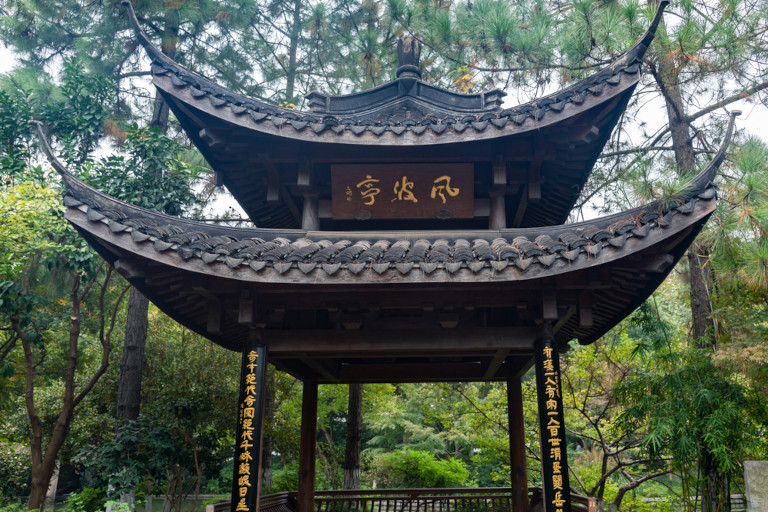Few temple statues draw as much attention as the mysterious figure enshrined in Suzhou’s Xiyuan Jiechuang Temple — a strange yet compelling presence whose story has intrigued visitors for centuries.
The Monk of Ten Imperfections
Inside the Hall of Five Hundred Arhats stands a clay statue of a peculiar figure known as the “Mad Monk,” also referred to as the “Fengbo Monk” — a name associated with the Fengbo Pavilion, where a national hero met a tragic end. As legend has it, this eccentric monk lived during the Southern Song Dynasty at Lingyin Temple, where he served as a humble temple cook. He often wandered barefoot and spoke incoherently, leading many to assume he was mad.
He bore 10 physical deformities: a crooked mouth, a hunched back, crossed eyes, protruding ears, a scabby scalp, a clubfoot, claw-like hands, slanted shoulders, a pigeon chest, and a twisted nose. Because of this, he was called the “Monk of Ten Imperfections.”
It’s said that he was once a poor scholar who, despite his literary talent, failed the imperial exams repeatedly. Disillusioned by a corrupt society, he renounced worldly ambition and became a monk. Though his behavior was erratic, it masked a clear sense of purpose.
A deadly conspiracy unfolds
During this turbulent period, the Jin general Wanyan Zongbi launched a campaign against the Central Plains. Defending the nation was Yue Fei, a brilliant and loyal general who led the Song army to repeated victories. But back in the capital, the treacherous minister Qin Hui and his wife Lady Wang were secretly collaborating with the enemy. Under the pretense of imperial orders, they summoned Yue Fei back to the capital and ultimately orchestrated the execution of both him and his son at the Fengbo Pavilion.

Some time later, Qin Hui and Lady Wang visited Lingyin Temple to offer incense. Inside the temple, they were startled to see a poem freshly written on the wall:
Binding a tiger is easy; releasing it is hard.
The vicious scheme behind the east window outwits all others.
Alas, that woman wields a long, sharp tongue,
Breaking my heart and chilling my soul.
Recognizing the reference to the events at Fengbo Pavilion, the couple flew into a panic. Demanding to know who had dared to write the verse, Qin Hui summoned the abbot. The abbot, in turn, brought forward the Mad Monk — a disheveled figure with a filthy face, tattered robes, and twisted limbs.
Qin Hui sneered at the monk’s appearance. “With that look, how can you call yourself a monk?” he mocked.
The Mad Monk calmly replied: “My body may be flawed, but my heart is pure — unlike yours, which speaks like a Buddha, but harbors a serpent.”

When asked whether he had written the poem, the monk answered: “If you could commit such crimes, why shouldn’t I write about them?”
“What’s that broom for?” Qin Hui demanded.
The monk raised it high. “This broom isn’t just for sweeping floors. It’s meant to sweep away traitors!” he declared — and lunged at Qin Hui. The minister collapsed in fright. By the time he came to, the Mad Monk had disappeared without a trace.
A guardian in disguise
His dramatic act wasn’t a mere performance. The Mad Monk had learned that Qin Hui and Lady Wang would come to offer incense and draw a fortune slip — one that would surely foretell disaster. Fearing that Qin Hui would take his anger out on the monks or even desecrate the temple, the monk intervened to prevent harm. He would not have revealed himself otherwise.
As for Yue Fei, though betrayed and executed under false charges, his loyalty to the nation was not forgotten. Years later, during the reign of Emperor Xiaozong, he was posthumously exonerated and granted the honorary title “Yue Wumu.”
The Mad Monk’s confrontation with Qin Hui became a symbol of moral courage in the face of tyranny. His story spread widely through plays, novels, and oral tradition, including detailed accounts in The Complete Biography of Yue Fei written during the Qing Dynasty and the Yuan-era tale The East Window Plot.
Today, statues of Qin Hui and Lady Wang kneel before Yue Fei’s tomb in Hangzhou — an eternal image of disgrace and shame. In contrast, the Mad Monk is revered as a guardian of righteousness, honored as one of the Five Hundred Arhats in Suzhou’s temple, where incense still burns in his name.
This tale serves as a lasting reminder: however cleverly evil may disguise itself, the truth cannot be buried forever. Justice may be delayed, but it will not be denied.
Translated by Katy Liu
Follow us on X, Facebook, or Pinterest

